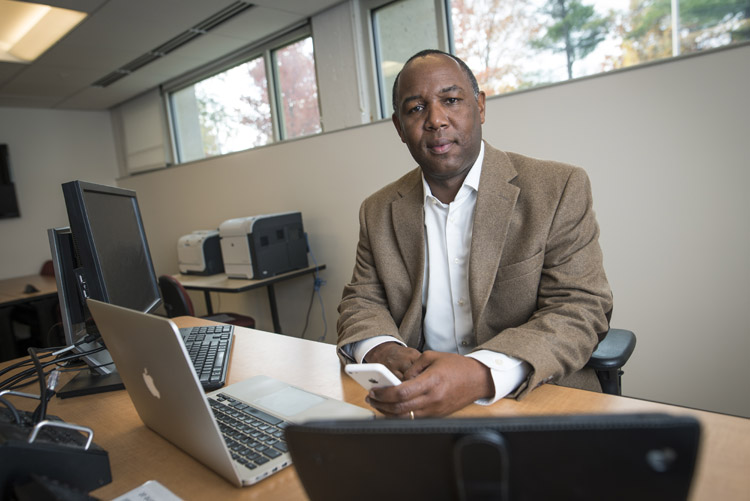
Kevin Clark, Director, Center for Digital Media Innovation and Diversity. Photo by Evan Cantwell.
George Mason University professor Kevin Clark is certain that African-American youth in low- and middle-income communities can enhance their education and even change their lives through the use of technology.
That belief was the basis for his groundbreaking study that examines how such youth and parents use technology to learn outside of normal educational environments.
The study—The Digital Lives of African American Tweens, Teens, and Parents: Innovation and Learning with Technology—conducted with Kimberly Scott of Arizona State University and funded by the Bill and Melinda Gates Foundation, has been reported on by Politico, Education Week, Diverse Issues in Higher Education and Ebony magazine.
“The reason we came up with this grant was to paint a picture of how African-American families are using technology, and not just how much,” said Clark, a professor in George Mason’s Division of Learning Technologies in the College of Education and Human Development and director of Mason’s Center for Digital Media Innovation and Diversity.
“A lot of research says, oh, the kids spend a certain number of hours on media, or they watch TV five hours a day,” continued Clark, who presented his findings at an event sponsored by Common Sense Media in the Rayburn House Office Building on Capitol Hill. “We wanted to dig deeper and get a sense of what they were doing during that time. What’s the interaction between members of the family and the household? What role does the community as a whole play?”
The most revealing finding of the study that surveyed more than 1,000 African-Americans, ages 11-17, was that while 87 percent said they were confident in their basic computer knowledge, and many wanted to learn advanced technology skills, they were less likely to learn from their peers and parents. That might be because they simply do not have the knowledge and must learn from people outside the community or, perhaps, not learn at all.
“It illustrates the significance of a proximal, supportive learning ecosystem comprised of parents, teachers, community members, the creators of technology and its users,” Clark said. “It also makes evident that focusing on teens as end-users is insufficient. Families and communities should be provided with the educational and technology resources that enable them to play a role.”
Said Kimberly Sheridan, associate professor of educational psychology at Mason: “Kevin has a dogged, generous persistence in his education and research projects around envisioning how technologies can help the lives of individuals and communities, particularly those traditionally underserved.”
Clark said his research sprouted from experience, specifically from two advocates who pushed him to achieve as a student at critical points in his life.
As an 8-year-old, after the sudden death of his mother, Clark and his twin brother moved from the Bronx to live with their grandmother in Greensboro, N.C. School officials there wanted the boys to repeat second grade. Their grandmother insisted a test determine their placement. The boys scored well enough to be in third grade, Clark said.
Because the boys did not believe their grandmother could afford to send them to college, they did not plan to attend. But Clark said a high school guidance counselor, noting their standardized test scores, insisted they apply to three schools each. Clark ended up at North Carolina State, his brother at the University of North Carolina.
“My grandmother’s effort and the action of a caring education professional changed my educational trajectory and the course of my life,” Clark said. “Because of them, I advocate for young people to have access to educational opportunities regardless of their income and ethnicity. My goal is to enable youth to define themselves, their families and communities, and help them realize they can shape and change their lives rather than waiting for someone to do it for them.”
His study is another step in that direction.
